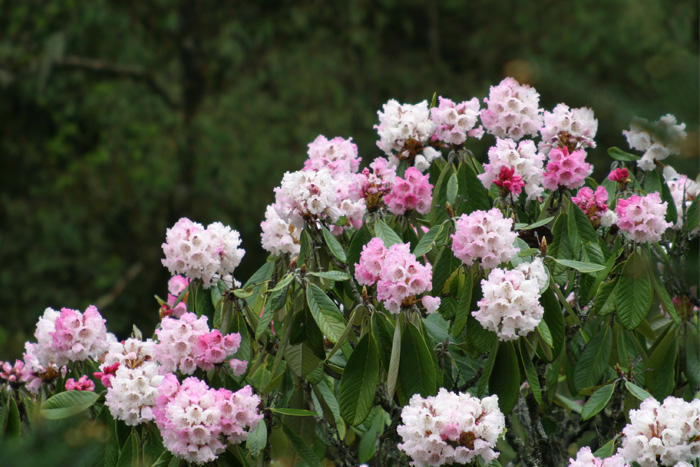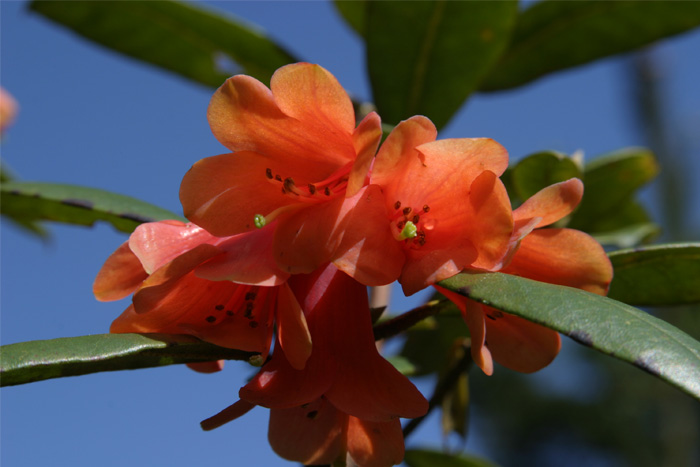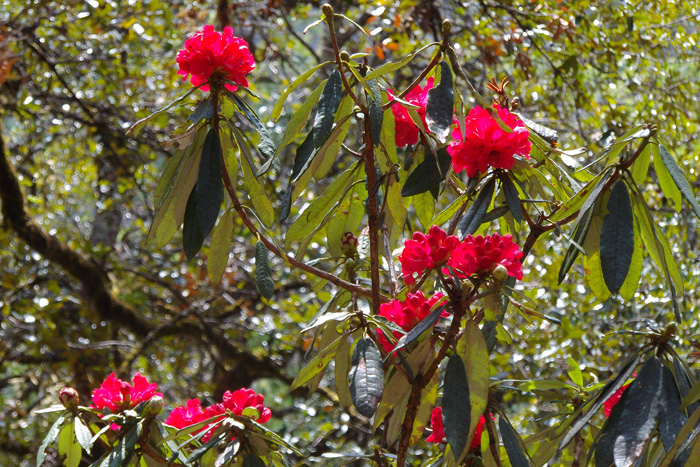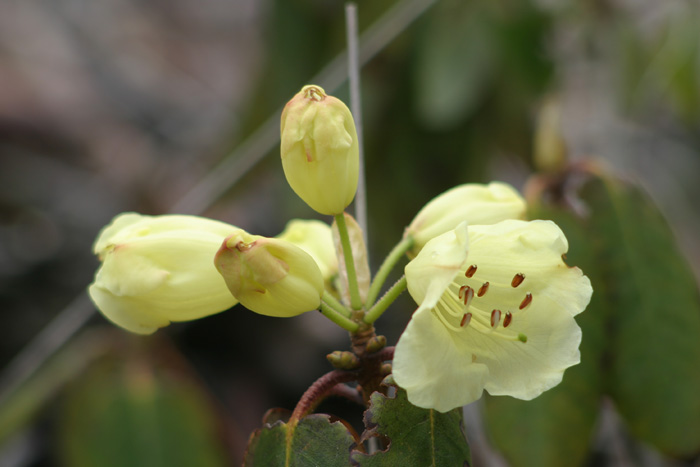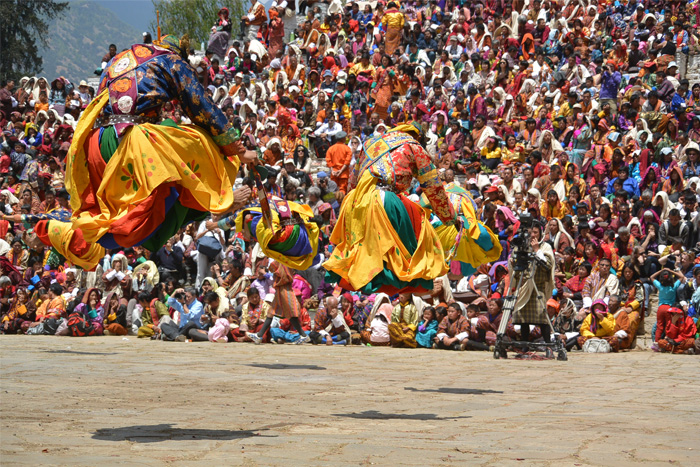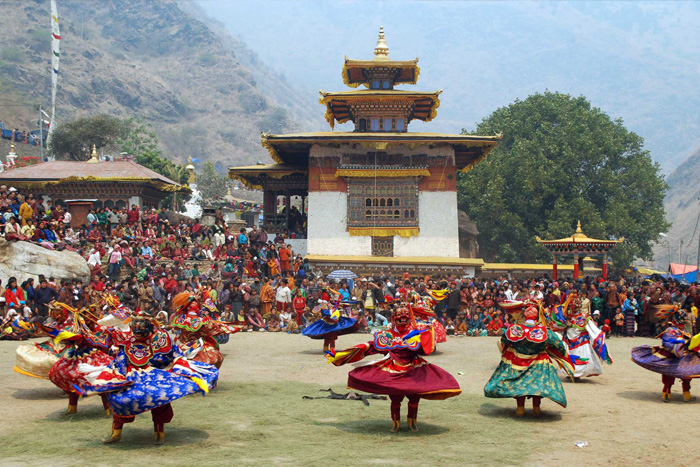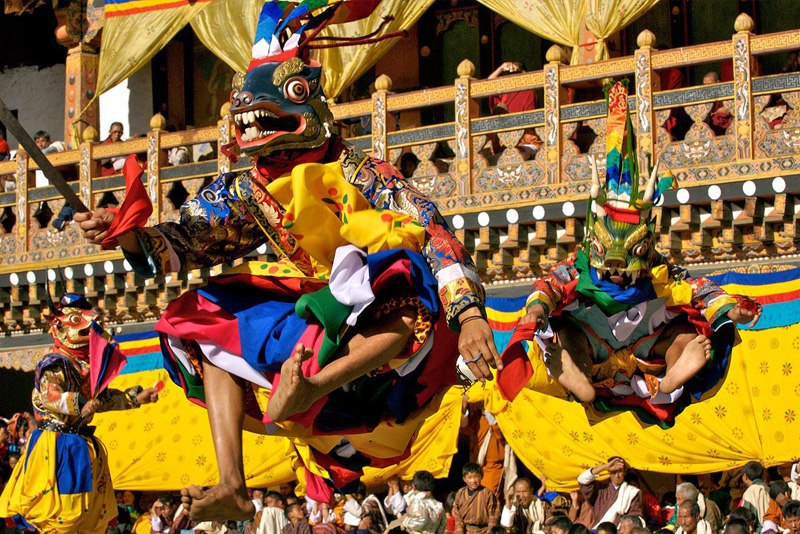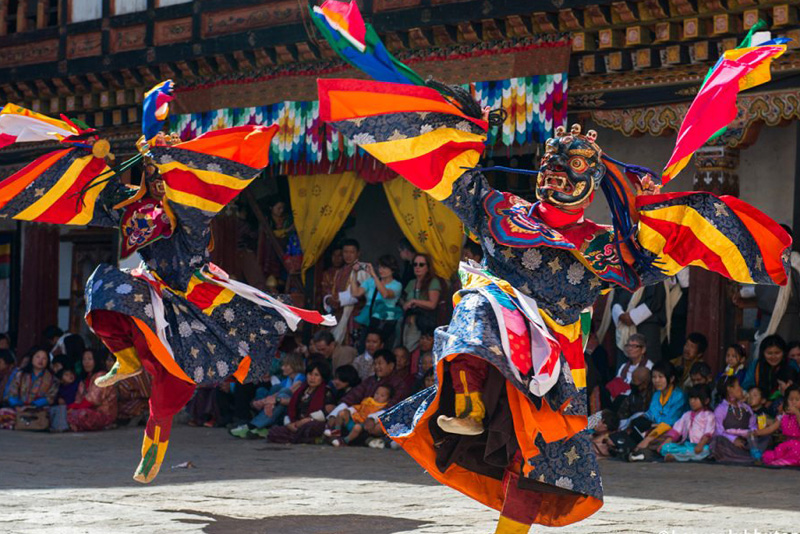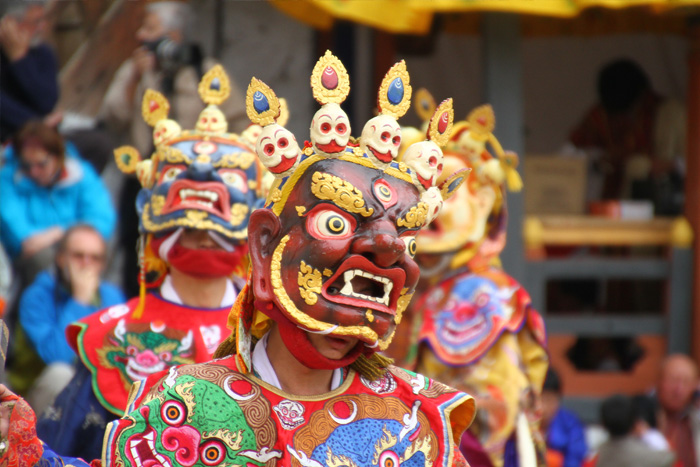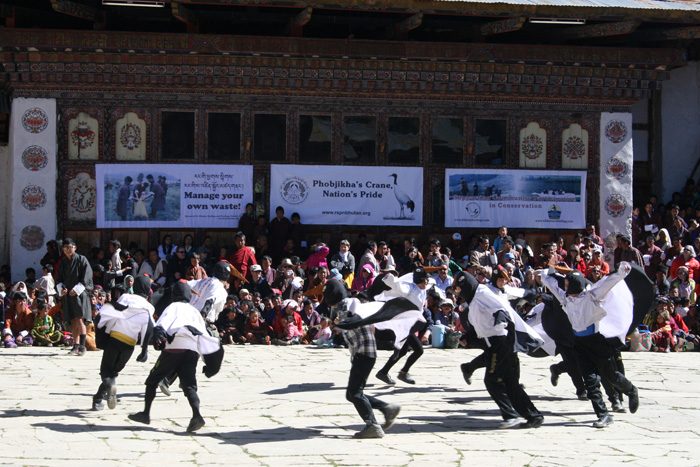Amidst the King of Shrubs (Rhododendron)





Tour Summary
Rhododendrons, referred to as the King of Shrubs are regarded by many as the best flowering evergreen plant for the temperate landscape. Bhutan has more than 46 species of the shrub, growing at elevations ranging from 1200 m to 4800m. April to July is the main blooming season for Rhododendrons. Bhutan also has a special park dedicated to the flower and has established a botanical garden at Lamperi, about an hour journey from Thimphu. An annual Rhododendron festival is also held.
Duration: 11 days
Highlights- Flora, fauna, culture, people
Upon arrival at Paro, you will be received by our representative and escorted to your hotel. After a quick lunch, we drive to Chelila Pass (3,810 m, over 12,000 ft), an alpine ecosystem with several endangered and endemic species. Nearly all flora species found here are medicinal. Some rare species found are Meconopsis horidula, Meconopsis grandis, Fetillsria chirhosa and aconitum Spp. Amongst the Rhododendron specialties, we will find Rhododendron anthopogon, Rhododendron nivale and Rhododendron setosum.
We drive back to Paro and halt the night at the hotel.
Day 2: Paro – Punakha/Wangduephodrang
After breakfast, we begin moving to the interiors of Western Bhutan and divert from the expressway junction to Wangduephodrang. (If we come straight we enter Thimphu). About half an hour from the junction, we reachDochula Pass (10,450 ft, or 3,100 meters), which provides a 360 degree panoramic view of the highest unclimbed mountains of the world, one considered a vital conservation area with significant altitudinal and associated changes in vegetation within short distances. It is also a traveler’s delight augmented by the beauty of the 108 stupas and the Druk Wangyal Temple.
Rhododendron festivals are held annually here. The park is part of a 47-sq mile critical biological corridor connecting the Jigme Singye Wangchuck National Park and the Jigme Dorji Wangchuck National Park. It has cool broad leaf forests, mixed conifer forests, fir and sub-alpine forests and the temperate rain forest with hundreds of species of fauna. Some of the rare species found in the park are the monal pheasants, blood pheasants, musk deer, tiger, leopard, red panda and the leopard cat.
We will spend a lot of time scouring for Rhododendrons here.
After lunch we will proceed to Wangduephodrang. We will visit the ruins of the majestic Wangduephodrang Dzong, ravaged tragically by a fire in 2012.
Night halt in hotel.
Day 3: Wangdue to Phobjikha
- After breakfast, we proceed to one of Bhutan’s most protected areas, the Phobjikha Wildlife Sanctuary, the winter roosting habitat of Black Necked Cranes who fly in from Tibet and Mongolia. It is a spectacular valley and the landscape is awesome, to say the least. The journey is through a splendid landscape of alpine forests, meadows, and flowers, including different species of Rhododendrons, Legumes, Magnolia, Weeping Cypress (national tree of Bhutan), etc.
Halt at Phobjikha.
- Day 4: Phobjikha to Bumthang.
We Drive to Bumthang valley (200km) through Pelela Pass which ascends up to 3,340m and traditionally the dividing junction between east and western Bhutan. The drive takes us through thick dwarf bamboo, Yak habitats, and Rhododendrons with beautiful hues of red, white, and yellow.
En-route, we will see the spectacular Trongsa fortress, the ancestral palace home of Bhutan’s Kings, the Watch Tower, and the town before driving to Bumthang valley across the Yotongla Pass.
Halt in Bumthang.
Day 5: Bumthang to Thrimshingla
After breakfast, we will drive to Ura valley, and see the “Burning Lake” (Mebertasho), associated with the great Treasure Discoverer (Terton) Pema Lingpa. On the way, we will for various species of Rhododendrons. You will also encounter species of Rubus, Acer, Aconitum, Delphinium, Ranunculus, Clemantis, few species of orchid such as Coelogyne, Pleione, Cephalenthera, conifers such as Fir, Hemlock, Pine, Juniperus, Primulas, Androsac, etc.
We then drive up to Thriumshing La National Park covering Bumthang, Lhuentse, Zhemgang, and Mongar districts. Established in 1998, with an area of 905 km2 and with huge expanses of some of the last remaining stands of cool temperate broadleaved forests and old fir growth in the entire Himalayas, Thrumshingla National park is home to some of the world’s most endangered flora and fauna. More than 622 plants species occur in Thrumshingla National Park, comprising of 152 medicinal plants and 21 species endemic to Bhutan. Rhododendrons flowers and add beauty to pristine fir forests at the higher elevation.
Justifiably Bhutan’s showcase of Rhododendrons, one area has been designated as Insitu-Rhododendron Garden.
The Garden showcases the Kingdom’s rhododendron diversity in their natural habitat in an area of approximately 2 hectares harbouring 22 different species of rhododendron in assemblage.
The Park is also home to many endemic species namely Daphne ludlowii, Lobelia nubigena, Vanda griffithii, Rubus sengorensis, and Pedicularis spp. It is also has Red Panda, reptiles, amphibians and different avian fauna.
We will camp for the night there.
Day 6: Thrimshingla Camp to Bumthang
We will spend some time at the park and drive further to Sengor, where we see some species of the flower. The drive is an exhilarating one through the alpine down to the tropics.
After lunch at Sengor, we move back to Bumthang.
Halt at Bumthang.
Day 7: Halt at Bumthang
A place revered for its sanctity and one of Bhutan’s most beautiful valleys, you could spend the day there visiting places of historical importance and interact with the people of Bumthang.
Day 8: Bumthang to Thimphu
It is a long drive and so we begin early. Enroute, we stop for lunch at Chendebji, a historical monument build by King Shida and resembling the Boudanath in Nepal.
Upon arrival at Thimphu, we check into the hotel and relax for the night.
Day 9: Thimphu halt
Bhutan’s capital is not only the country’s most modern city but also a treasure house of some of the Kingdom’s most spectacular cultural centres. A day in the capital is worth every penny and here you can visit several places of significance, including the historic Tashichhodzong, which houses the office of the King, the Throne Room and some government ministries. The country’s largest Buddha statue, Takin Zoo, local Bhutanese paper factory, Memorial Chorten, Folk Heritage Museum, National Institute of Traditional Medicines etc, are other places you can visit.
Day 11: Thimphu – Paro
You will be driven from Thimphu to Paro for your departure from the country. Our representative will escort you.
|
GROUP SIZE: Any group Size |
TOUR MONTHS: Throughout year |
Minimum Daily Package Inclusions
⇒ Accommodation in 3 stars approved hotels
⇒ US$ 40 per person visa fees (single entry only)
⇒ Visa arrangement for your stay in Bhutan as per the itinerary
⇒ 35% SDF – Sustainable Development Fees
⇒ Meals – breakfast, lunch and dinner
⇒ English speaking licensed tour guide
⇒ Transfers and sightseeing as per the itinerary, check vehicles
⇒ Entrance, museums and park fees indicated in the itinerary
⇒ Bottled drinking water throughout the journeys
Minimum Daily Package Exclusions
⇒ Flight Fares of any kind (domestic or international)
⇒ Personal Expenses, phone calls, laundry, shopping, etc
⇒ Gratitude or Tipping
⇒ Single Room Supplement
⇒ 4 stars & 5 stars Hotels/Resorts
⇒ Language Speaking Guide
⇒ Travel and Medical Insurance
⇒ Extra Activities Cost (Cycling, Motorbike, River Rafting, Horse Ride, etc)
Related Tour
-
Paro Tshechu
Started by Zhabdrung Ngawang Namgyal, and Penlop...
-
Druk Wangyel Tshechu
Druk Wangyel Tshechu is a one day...
-
Gomphu Kora Tshechu
The Kora festival at Gomphu Kora was...
-
Jambay Lhakhang Drup
The Naked Dance of Jampa Lhakhang Drub...
-
Punakha Tshechu
One of the biggest festivals in the...
-
Chorten Kora Tshechu
Unlike other festivals, this is one where...
-
Trashigang Tshechu
Held within the confines of Bhutan’s largest...
-
Thimphu Tsechu
Festivals are the biggest tourist attractions. Religious...
-
Black Necked Crane Festival
This is an expedition that will bring...


